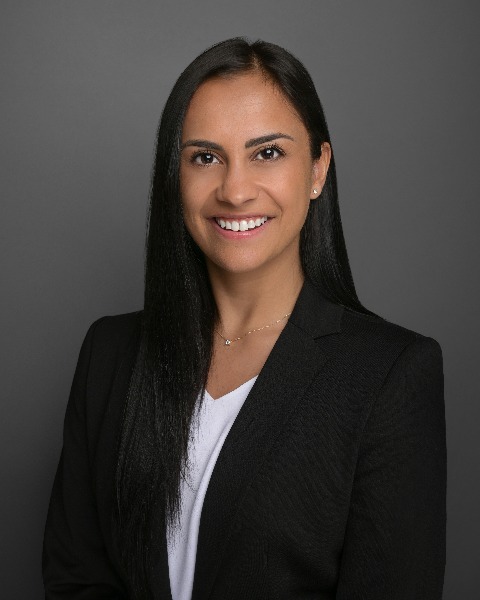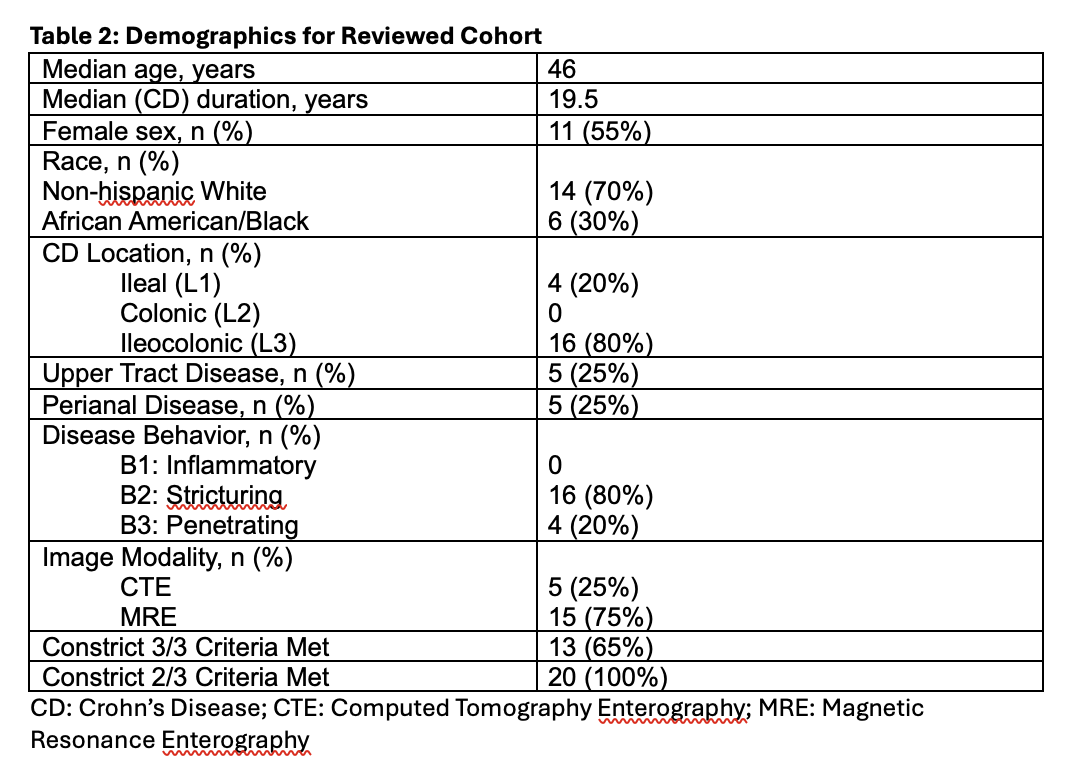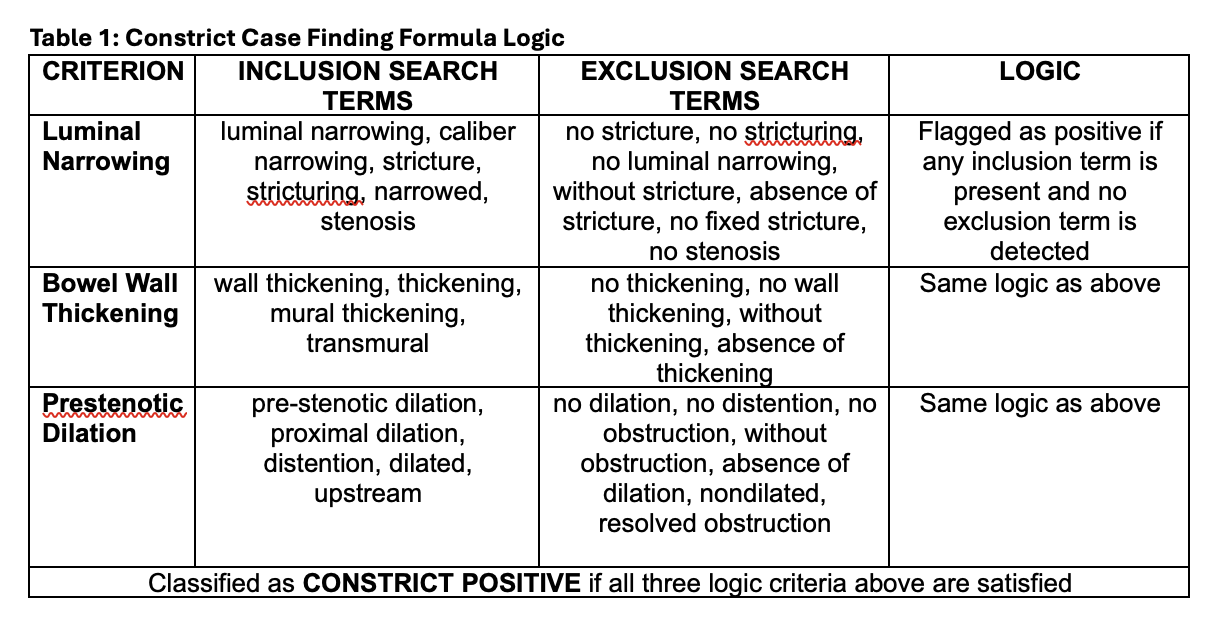Sunday Poster Session
Category: IBD
P1176 - Validation of a Logic Formula to Identify Strictures Among Crohn’s Disease Patients Using CONSTRICT Criteria
Sunday, October 26, 2025
3:30 PM - 7:00 PM PDT
Location: Exhibit Hall

Seema Belani, MD, MS (she/her/hers)
Washington University School of Medicine in St. Louis / Barnes-Jewish Hospital
Saint Louis, MO
Presenting Author(s)
Seema Belani, MD, MS1, Aravinda Ganapathy, MD, MS1, David Ballard, MD1, Juan Reyes Genere, MD1, Richard Tsai, MD1, Parakkal Deepak, 2
1Washington University School of Medicine in St. Louis / Barnes-Jewish Hospital, Saint Louis, MO; 2Department of Medicine, Washington University School of Medicine, St. Louis, MO
Introduction: The CONSTRICT criteria represent a consensus-based radiologic classification system for identifying small bowel strictures in Crohn’s disease (CD).1 Widely used in clinical and research settings, the criteria help standardize reporting and guide treatment.2 However, applying these criteria at scale is difficult due to variability in radiology report language and volume of imaging data.
Methods: We developed a case-finding logic formula to identify strictures meeting CONSTRICT criteria based on radiology report text. A Montage search identified 8,808 MRE and CT scans from 2015–2024 at Washington University/Barnes-Jewish Hospital and affiliate centers. The formula used inclusion/exclusion terms across three CONSTRICT criteria, flagging scans as CONSTRICT-positive if all three criteria were met (Table 1).
Results: After deduplication, 8,216 unique scans remained; 240 met all three CONSTRICT criteria using the formula. A fellowship trained abdominal radiologist re-reviewed a random sample of 20 flagged scans. The scans represented a cohort of patients that was 55% female, with a median CD disease duration of 19.5 years and predominantly stricturing (80%), ileocolonic (80%) disease phenotype (Table 2). The formula had a 100% positive predictive value (PPV) for identifying scans meeting at least two of the three CONSTRICT criteria, and a 65% PPV for identifying scans meeting all three. Extrapolated to the full dataset, this suggests that 156 of 240 flagged scans would meet the complete CONSTRICT definition.
Discussion: This logic-based approach reduced a large dataset to 240 targeted scans, supporting scalable identification of strictures without labor-intensive manual review. Limitations include: (1) the initial search targeted patients with Crohn’s disease strictures, not small bowel strictures broadly; (2) variability in radiographic descriptors (e.g., unclear bowel diameters or ambiguous terms near surgical anastomoses) may lead to false positives/negatives; (3) non-flagged scans were not re-reviewed, so negative predictive value (NPV), sensitivity, specificity and accuracy calculations could not be assessed; and (4) CONSTRICT lacks strict numeric diameter thresholds, complicating automation.
The logic formula can be embedded into natural language processing (NLP) systems to enable real-time identification of strictures at scale. Further validation in multicenter settings is needed to refine its accuracy and broader applicability.

Figure: Table 1: Constrict Case Finding Formula Logic

Figure: Table 2: Demographics for Reviewed Cohort
Disclosures:
Seema Belani indicated no relevant financial relationships.
Aravinda Ganapathy indicated no relevant financial relationships.
David Ballard: Direct Biologics – Consultant. Merck – Consultant.
Juan Reyes Genere: Boston Scientific – Consultant. Edulis Therapeutics Inc – Consultant.
Richard Tsai indicated no relevant financial relationships.
Parakkal Deepak: Arena Pharmaceuticals – Grant/Research Support, Personal or other fees. Boehringer Ingelheim – Grant/Research Support, Personal or other fees. Bristol Myers Squibb/Celgene – Grant/Research Support, Personal or other fees. Janssen – Grant/Research Support, Personal or other fees. Pfizer – Grant/Research Support, Personal or other fees. Prometheus Biosciences – Grant/Research Support, Personal or other fees. Takeda – Grant/Research Support, Personal or other fees.
Seema Belani, MD, MS1, Aravinda Ganapathy, MD, MS1, David Ballard, MD1, Juan Reyes Genere, MD1, Richard Tsai, MD1, Parakkal Deepak, 2. P1176 - Validation of a Logic Formula to Identify Strictures Among Crohn’s Disease Patients Using CONSTRICT Criteria, ACG 2025 Annual Scientific Meeting Abstracts. Phoenix, AZ: American College of Gastroenterology.
1Washington University School of Medicine in St. Louis / Barnes-Jewish Hospital, Saint Louis, MO; 2Department of Medicine, Washington University School of Medicine, St. Louis, MO
Introduction: The CONSTRICT criteria represent a consensus-based radiologic classification system for identifying small bowel strictures in Crohn’s disease (CD).1 Widely used in clinical and research settings, the criteria help standardize reporting and guide treatment.2 However, applying these criteria at scale is difficult due to variability in radiology report language and volume of imaging data.
Methods: We developed a case-finding logic formula to identify strictures meeting CONSTRICT criteria based on radiology report text. A Montage search identified 8,808 MRE and CT scans from 2015–2024 at Washington University/Barnes-Jewish Hospital and affiliate centers. The formula used inclusion/exclusion terms across three CONSTRICT criteria, flagging scans as CONSTRICT-positive if all three criteria were met (Table 1).
Results: After deduplication, 8,216 unique scans remained; 240 met all three CONSTRICT criteria using the formula. A fellowship trained abdominal radiologist re-reviewed a random sample of 20 flagged scans. The scans represented a cohort of patients that was 55% female, with a median CD disease duration of 19.5 years and predominantly stricturing (80%), ileocolonic (80%) disease phenotype (Table 2). The formula had a 100% positive predictive value (PPV) for identifying scans meeting at least two of the three CONSTRICT criteria, and a 65% PPV for identifying scans meeting all three. Extrapolated to the full dataset, this suggests that 156 of 240 flagged scans would meet the complete CONSTRICT definition.
Discussion: This logic-based approach reduced a large dataset to 240 targeted scans, supporting scalable identification of strictures without labor-intensive manual review. Limitations include: (1) the initial search targeted patients with Crohn’s disease strictures, not small bowel strictures broadly; (2) variability in radiographic descriptors (e.g., unclear bowel diameters or ambiguous terms near surgical anastomoses) may lead to false positives/negatives; (3) non-flagged scans were not re-reviewed, so negative predictive value (NPV), sensitivity, specificity and accuracy calculations could not be assessed; and (4) CONSTRICT lacks strict numeric diameter thresholds, complicating automation.
The logic formula can be embedded into natural language processing (NLP) systems to enable real-time identification of strictures at scale. Further validation in multicenter settings is needed to refine its accuracy and broader applicability.

Figure: Table 1: Constrict Case Finding Formula Logic

Figure: Table 2: Demographics for Reviewed Cohort
Disclosures:
Seema Belani indicated no relevant financial relationships.
Aravinda Ganapathy indicated no relevant financial relationships.
David Ballard: Direct Biologics – Consultant. Merck – Consultant.
Juan Reyes Genere: Boston Scientific – Consultant. Edulis Therapeutics Inc – Consultant.
Richard Tsai indicated no relevant financial relationships.
Parakkal Deepak: Arena Pharmaceuticals – Grant/Research Support, Personal or other fees. Boehringer Ingelheim – Grant/Research Support, Personal or other fees. Bristol Myers Squibb/Celgene – Grant/Research Support, Personal or other fees. Janssen – Grant/Research Support, Personal or other fees. Pfizer – Grant/Research Support, Personal or other fees. Prometheus Biosciences – Grant/Research Support, Personal or other fees. Takeda – Grant/Research Support, Personal or other fees.
Seema Belani, MD, MS1, Aravinda Ganapathy, MD, MS1, David Ballard, MD1, Juan Reyes Genere, MD1, Richard Tsai, MD1, Parakkal Deepak, 2. P1176 - Validation of a Logic Formula to Identify Strictures Among Crohn’s Disease Patients Using CONSTRICT Criteria, ACG 2025 Annual Scientific Meeting Abstracts. Phoenix, AZ: American College of Gastroenterology.
